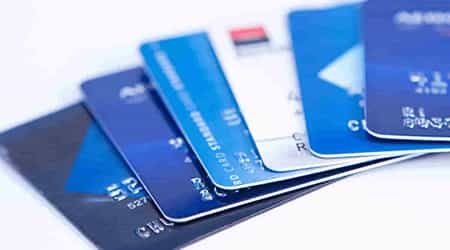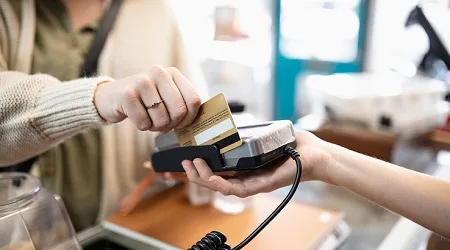If you’re heading to Europe to sightsee the Eiffel Tower, a Spanish flamenco dance or go on a business trip, you’ll want to find out common methods of payment in the specific country you’re visiting. Most European countries take Visa and Mastercard credit cards as a form of payment. Travel with a travel credit card to avoid all the foreign transaction fees that most credit cards charge.
However, you’ll need euros or the local currency in some countries like the Czech Republic, where restaurants and smaller shops may not be friendly to plastic. While there are European countries that use their own currency — for example, the Czech Republic and Hungary — the euro is the national currency of the majority of Western and Central European nations.
Our picks for traveling to Europe

- 0.50% APY on checking balance
- Up to 4.60% APY on savings
- $0 account or overdraft fees
- Get a $300 bonus with direct deposits of $5,000 or more
Travel card, debit card or credit card?
A prepaid travel card can be a good idea if you’re staying within the European financial zone and the United Kingdom. If you’re traveling to another destination like Croatia, the Czech Republic, Sweden or Hungary, you’re better off using a credit card that waives the fee for foreign transactions — no ATM fees are a bonus too.
While there are travel cards that don’t charge you for currency conversion — the back-end fees, exchange rate margin and juggling another account make a travel-friendly debit card a better option.
A credit card and debit card combination makes for a good mix to access cash and make purchases. A credit card is a must: Interest-free cards give you time to pay back your purchases, some cards offer free travel insurance and credit cards give you peace of mind through access to emergency cash.
Don’t use a credit card for cash withdrawals — it’s almost too expensive to justify. Use a debit card or a prepaid travel card to withdraw cash.
These are your options for spending money in Europe
Using a credit card
Look for travel-friendly credit cards that you can swipe without being charged a foreign transaction fee — typically 2% to 3% — or international ATM fee. For example, the Capital One VentureOne Rewards Credit Card will avoid the pesky foreign transaction fees while offering travel rewards (Terms apply, see rates & fees). Choosing a travel credit card often means that you get purchase protection, travel insurance or a rental car collision waiver as part of your benefits, helping you get more bang for your buck with your card.
Pros
- May have no international ATM fees
Cons
- Operator fees may apply
- Cash advance fees
Which credit card issuers are accepted in Europe?
You’ll find Visa and Mastercard to be widely accepted in Europe. Generally speaking, you’ll find merchants in Europe willing to accept American Express cards and even fewer that will take Discover cards. If you have an American Express card, you’ll have the best luck using it in areas frequently traveled by tourists or business travelers.
| Merchant acceptance | ATM acceptance | |
|---|---|---|
Visa | ||
Mastercard | ||
American Express | ||
Discover |
Compare travel credit cards
Explore top debit cards with no foreign transaction fees and travel credit cards by using the tabs to narrow down your options. Select Compare for up to four products to see their benefits side by side.
Using a debit card
Visa and Mastercard branded debit cards will work throughout Europe without a problem.
There are fees that come with international debit card use — mainly currency conversion fees and ATM fees. With a Betterment Checking debit card, you can get foreign and ATM fees reimbursed as you go to keep your wallet padded on your journey.
- Tip: Debit card providers like Bank of America and Barclays are members of a Global ATM Alliance that waives international ATM fees.
Pros
- May have no international ATM fees
- No ATM operator fees on European bank ATMs for cash withdrawals
Cons
- International ATM fee and currency conversion fee apply when withdrawing cash
Did you know?
You may be able to avoid the cash-advance fee and interest charges if you preload your own money onto your credit card. The rules are different for each provider.
The catch: You’re waiving some anti-fraud guarantees when you preload your own funds onto your credit card.
Using a prepaid travel card
A travel card can hold multiple international currencies, and you save on the fee for currency conversion. You can load euros and GBP on most travel cards, but few other European currencies will be supported.
Pros
- Multiple international currencies load euros and GBP on most travel cards
Cons
- Currency conversion may apply
- Conversion fee is almost double the charge than on debit and credit cards
Must read: Countries in Europe that haven’t adopted the euro
If you’re traveling to one of these European countries, consider using a debit card or credit card rather than a prepaid travel card. A currency conversion fee applies if you’re spending in a currency not loaded on the card. In most cases, the conversion fee is almost double the charge than on debit and credit cards.
“Although the United Kingdom is not a part of the Euro Zone, all travel cards let you load pounds sterling. Preload both euros and pounds and you can use the one card to spend on both sides of the English Channel.”
Paying with cash in Europe
There are places where you’ll need cash, but card payments are pretty standard throughout Europe. Contactless card payments are common in places like France and Germany, but cash is necessary if you’re heading off the beaten track — places like smaller Greek islands predominantly use cash.
Pros
- Payment flexibility
- Convenience
Cons
- Difficult to manage expenses
- Higher risk of theft
Using traveler’s checks
It’s not necessary to take traveler’s checks with you on your trip to Europe. Financial institutions offer money-back guarantees if you’re the victim of fraud, and there’s a limited number of places where you can cash your checks.
Pros
- Acceptance
- Security
Cons
- Can be costly with initial purchase charges
- Not all merchants accept traveler’s checks
European currency
Although the euro was officially introduced in 1999, European citizens didn’t start to see the new notes and coins till sometime in 2003. The notes are all different colors and feature different architectural designs from different eras.
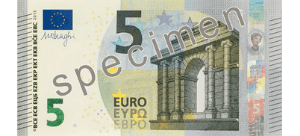 | 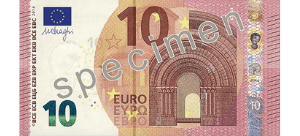 | 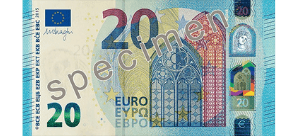 |
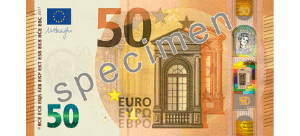 | 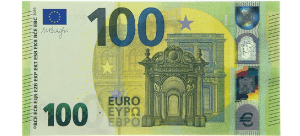 |
The main banks in Europe are:
- HSBC Holdings plc, GBR
- BNP Paribas SA, FRA
- Crédit Agricole Group, FRA
- Deutsche Bank AG, DEU
- Banco Santander SA, ESP
- Barclays plc, GBR
- Société Générale SA, FRA
- Groupe BPCE, FRA
- LLoyds Banking Group plc, GBR
- ING Groep NV, NLD
- UniCredit SpA, ITA
- Royal Bank of Scotland Group plc, GBR
- Intesa Sanpaolo SpA, ITA
- Crédit Mutuel Group, FRA
- UBS Group AG, CHE
Buying currency in the US
If you really want to buy euros before you leave, consider nonbank foreign exchange providers such as Travelex. Travelex lets you order cash online and pick it up at the airport before you leave.
You won’t need euros to pay for your visa when you arrive in Europe. Americans get an automatic 90-day visa on arrival.
Live Rate
Refreshing in: 60s | Sat, Jun 01, 09:43PM GMT
Exchange rate history
It’s very difficult picking the future movement of currency pairs, especially the top two traded currencies in the world. The euro was adopted in 1999, and in 2002 it was introduced as the legal tender — circulating and being used in 12 countries.
The value of the dollar next to the euro dropped significantly in 2008 when an economic crisis made its way around the world. For the last three years, 1 euro has been worth about $1.10 to $1.30.
Find cash and ATMs in Europe
Most airports and banks across Europe will house ATMs inside that are friendly to Visa and Mastercard, though you may see Visa’s Plus or Mastercard’s Maestro or Cirrus symbols on the machines. When you’re withdrawing cash abroad, it’s handy to use an account that doesn’t charge currency conversion or international ATM fees. The Betterment Checking debit card, for example, reimburses these foreign fees, leaving more cash in your account to spend on your travels.
How much should I budget to travel in Europe?
Countries like France and Germany are a touch more expensive than places like Greece, but no matter where you are in Europe, your trip is going to be as low-cost or expensive as you let it be.
Some basic prices across Europe
Accommodation is likely to be your biggest expense when you’re visiting Europe. When it comes to food, if you’re eating in a restaurant, prices will be higher than grabbing a bite on the street (gyros in Greece), trapizzino in Rome, or a jambon et fromage baguette (ham and cheese sandwich — far better than it sounds) in France are all less than five euros.
We’ve included a snapshot of some prices for budget, mid-range and top-end hostels and hotels in different European countries below. All prices are in US dollars.
| Greece (Athens) | Germany (Berlin) | France (Paris) | Italy (Rome) | |
|---|---|---|---|---|
| Accommodation | Hostel $15 per night | Hostel $15–$25 | Hostel $35 per night | Camping $15 per night Hostel $25 per night |
| Meals | Gyros (street) $3.50 Small beer (supermarket) $1–$2.50 | Currywurst (street) $3.50 Beer (supermarket) $2.50 | Baguette (supermarket) $1.75 Cheese (supermarket) $3.50 Average wine (supermarket bottle) $2.25–$8 | Pizza (restaurant) $6–$12 Wine (restaurant) $6–$12 per glass |
| Activities | Walk around the Acropolis and Parthenon (pay $35 to go inside or enjoy the spectacular view from the outside for free) | Walking tour of Berlin Free (although it’s polite to tip the guide a couple of euros at least) | Get the food items mentioned above and camp at the Champ-des-Mars for a view of la Tour Eiffel. | Walking tours of Rome Free (plus a tip for the guide) |
*Prices are approximate and based on summer seasonality and are subject to change.
In most European countries, you can expect to pay anywhere from 10 to 30 euros for a meal in a mid-tier restaurant. Once you hit 5-star restaurants, prices will be comparable to high-end restaurants in the US.
- Tip: If you’re at a restaurant, the plat de jour (plate of the day) will be one of the cheapest and best-tasting dishes on the menu.
Case study: Kyle's experience
During my Eurotrip, I dropped pins on the map in Amsterdam, Bruges, Paris, Arles and Provence. I brought along my Wells Fargo Propel American Express, Wells Fargo Platinum Visa, Wells Fargo debit card and $500 USD.
When I landed in Amsterdam and was waiting at baggage claim, I spotted a local ATM and withdrew 100 euros using my debit card. The withdrawal cost me $113.49, plus a $5 non-Wells Fargo ATM transaction fee. I didn’t mind the fee because this was enough to buy a SIM card and catch a train downtown — and it left me with about 70 euros.
It didn’t take long to realize that I made a mistake with the credit cards I’d brought. While the Wells Fargo Propel American Express® Card had no foreign transaction fee, I neglected to research what the American Express acceptance rate was in Europe — not good. And I didn’t want to use my Wells Fargo Platinum Card because that came with a 3% fee for overseas purchases.
If I was traveling alone, I would have come home to a credit card bill riddled with fees. Luckily, my partner brought along her United℠ Explorer Card, which is a Visa (high acceptance rate) and has no foreign transaction fees. Since then, I’ve gotten my own United℠ Explorer Card.
As for withdrawing money from ATMs, I only took out another 100 euros for tipping and small purchases. And the $500 USD I brought along? That, and then some, went right to my partner to repay the money we spent on her credit card.
One piece of advice: Don’t be like me and rely on your partner’s credit card.
Travel insurance for Europe
Eurotrips are almost a compulsory rite of passage for young Americans who want to cross the pond, but don’t let your sense of adventure get you in trouble. Protecting your European vacation with travel insurance is a smart way to ensure that you are financially protected against unexpected travel expenses. Travel insurance may cover:
- Cancellation
- Lost or stolen luggage
- Emergency medical and dental
- Evacuation
- Personal liability
More guides on Finder
-
Travel money guide: USA
How to pay, how much to bring and travel money suggestions for your trip to USA.
-
Travel money guide: South Africa
How to pay, how much to bring and travel money suggestions for your trip to South Africa.
-
Travel money guide: Sri Lanka
How to pay, how much to bring and travel money suggestions for your trip to Sri Lanka.
-
Travel money guide: Mexico
How to pay, how much to bring and travel money suggestions for your trip to Mexico.
-
Travel money guide: Portugal
How to pay, how much to bring and travel money suggestions for your trip to Portugal.
-
Travel money guide: Hungary
How to pay, how much to bring and travel money suggestions for your trip to Hungary.
-
Travel money guide: Ecuador
How to pay, how much to bring and travel money suggestions for your trip to Ecuador.
-
Travel money guide: Fiji
How to pay, how much to bring and travel money suggestions for your trip to Fiji.
-
Travel money guide: Japan
How to pay, how much to bring and travel money suggestions for your trip to Japan.
-
Travel money guide: South America
How to pay, how much to bring and travel money suggestions for your trip to South America.
Ask a Question


